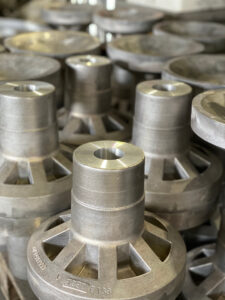Pros and Cons of Die Casting: Is it Right for You?
A lot of people reach out to us and want to learn more about die casting. We offer full-service die casting, and we know this process inside and out. In fact, there are some major pros and cons of die casting that you might not be familiar with.
In this guide, our die casting experts will explain the pros and cons of die casting. The goal is to teach you the perfect application for this process.
What Is Die Casting?
Die casting is a type of manufacturing that involves pushing molten metal into a cavity, pressing it together, letting it cool, and getting a solid metal part.
Certain model cars, like the small ones you would see at a convenience store, might have been die cast. This gives you an idea of how precise die casting can be, and how small the parts can be.
This manufacturing process works a lot like injection molding, but it uses metal instead of plastic. Since the metal needs to be completely melted, metals with lower melting temperatures are typically used — commonly, we use aluminum, zinc, and magnesium-based metal alloys.
We can also fabricate the metal cavity (also called die, or tooling) for your project. It’s important that you use an experienced die fabricator, since there are a lot of subtle nuances that can ruin your project if they are forgotten.
Pros of Die Casting
Let’s start with some benefits of die casting.
Achieve a Great Surface Finish
Die casting is a great way to achieve a smooth surface finish. The best part? You don’t need to do any expensive or time-consuming post-processing — the parts are smooth right from the die after being removed.
This is due to how die casting works. With the pressure and force that these machines operate under, all of the roughness is smoothed out against the walls of the die cavity.
Low-Cost Way for High-Volumes
Die casting is typically used when you want to make a lot of metal parts without spending a ton. The biggest cost is the upfront tooling cost, then you see a dramatic reduction in per-unit costs as you make more parts.
A die casting operation can make dozens or hundreds of parts in a single day of running. This leads to very favorable turnaround times at affordable pricing.
To make very large volumes via CNC machining takes much longer and costs a lot more than using a die casting operation.
Offers Great Accuracy and Precision
Another great thing about die casting is that it’s very repeatable. It can make parts with almost identical dimensions over and over again. This is thanks to the accuracy and precision offered by a good die casting manufacturer.
The tooling offers incredible tolerances, and the operation involves pressurizing the molten metal until the entire cavity is filled.
If you want to make a hundred parts that are dimensionally identical, then die casting is the right way to go.

Cons of Die Casting
Die casting also comes with some downsides. Let’s review them in this section.
The Die Is Typically Expensive
We mentioned that the tooling is expensive, and we should elaborate a bit more — the cavity that makes your parts can cost tens of thousands of dollars. Why is it so high? It’s largely thanks to the tooling, expertise, and complexity of making die cast tooling.
Not any machine shop can put together a die that works well and achieves the precision you need, hence the higher charge.
Cannot Be Used with Ferrous Metals
If you want to die cast with stainless steel or cast iron, you’re out of luck. Any ferrous metal (as in, contains iron) cannot be used in die casting. The melting temperature of ferrous metals is too high and makes the metal infeasible to die cast.
You’ll typically choose between metals that contain aluminum, zinc, tin, and magnesium.
However, these metals are still really impressive. Aluminum offers a lot of strength and flexibility, and most die casting projects don’t need high-strength parts made out of stainless steel.
Still, it’s worth knowing the material limitations of this process.
Harder to Make Massive Parts
Another limitation is the size of the part you can make. Die casting is phenomenal at making smaller parts, but it starts to lose its momentum as you design bigger parts. For instance, you could never die cast a pontoon boat.
Larger parts are more susceptible to get bubbles and surface defects on the part. With a larger cavity, it’s harder to force all the molten metal into the mold, filling every corner.
For really big parts, you’re better off using some form of CNC machining.
Conclusion
As you just learned, die casting is a great option if you want to make smaller items in large quantities and low prices. Unfortunately, you can’t make stainless steel parts in a die casting operation, and you can’t fabricate really large items.
If you want to learn more about die casting, feel free to reach out. You can also get a free quote from our die casting experts in-house. You can trust Rapid Axis for high-quality die-cast parts.
